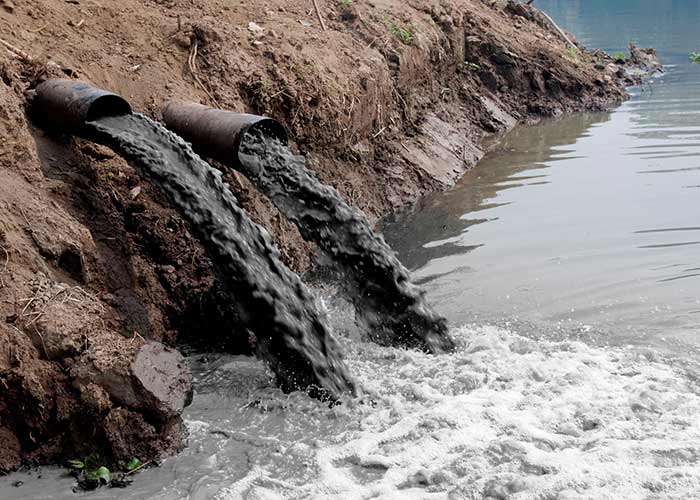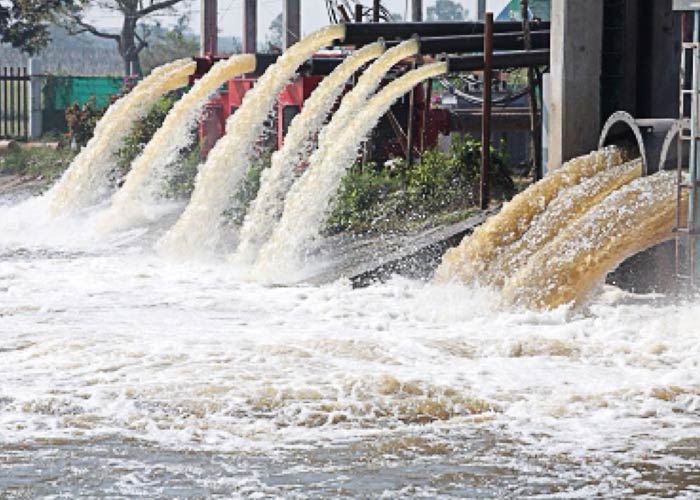Climate change refers to the extreme change in climate due to the rapid increase in the emission of greenhouse gases (GHG). Mainly coal, oil and natural gas are considered to be responsible for the emission of greenhouse gases. When the infinite rays of the sun reach the surface of the Earth, a small part of them is absorbed by greenhouse gases into the atmosphere of the earth. This causes the temperature of the Earth to rise. This much heat is necessary to make life possible on the Earth, otherwise the whole Earth will be covered with snow. But when these gases absorb more heat than required, the average temperature of the Earth increases and the problem of global warming is created.
Climate change, due to global warming, is a very worrisome issue of our times. The world is paying a heavy price of increase in population and rapid economic growth as this progress is not benign and sustainable for the environment. The amounts of GHG such as Carbon dioxide (CO2), methane (CH4), chlorofluorocarbons (CFCs), nitrous oxide (N2O) and tropospheric ozone (O3) are increasing in the environment, and the natural balance is deteriorating. Due to the burning of fossil fuels, coal, oil and natural gas, the GHG level is increasing in the atmosphere.
Carbon dioxide is increasing in the atmosphere due to gaseous emissions and pollution caused by industries. As we are also destroying trees, the carbon dioxide accumulated in the trees is also released in the environment. Due to increase in farming, diversity in land use and many other sources, there is large-scale secretion of gases like methane and nitrous oxide into atmosphere.
Nature increases its power to withstand the side effects of this tampering and keeps on reviving. But in order to enjoy the pleasures of life, man makes artificial objects, which do not rot and re-enter the natural life cycle. These are synthetic substances, solids, liquids, and gases which pollute the soil, water and air, affect entire vegetation and organisms.
Climate change has both internal and external reasons. Internal reasons include changes in natural processes within the climatic system (e.g. heat circulation, volcanic eruptions) or man-made (e.g. increase in greenhouse gases and dust emission).
Natural Causes of Climate Change
Many natural causes are responsible for climate change such as the shifting of continents, volcanoes, sea waves and the Earth’s rotation. Earth’s climate takes thousands of years to cool down or heat by one degree. The continuous heat released by volcanoes, finer ash and gases increase the temperature of the atmosphere. The changes that occurred in the Earth’s climate in the Ice Age cycle were due to volcanic activity, changes in forest life, changes in sun’s radiation, comets, meteorites and natural changes, etc.
- Cyclic changes
Many geologists claim that global warming, due to the intensity of natural calamities and the increase in temperature of the Earth, is the result of cyclical changes occurring in the world. They say that such cyclical changes have happened in the past, due to which we have experienced the Ice Age and have come out of it too.
- Continental Drift
The continents that we are familiar with today formed hundreds of millions of years ago when the terrain began to separate. The effect of this fragmentation also took place on the weather as it changed the physical characteristics of the terrain, its location and the location of the water bodies. This discontinuity of the terrain changed the seas and the winds of the waves, which influenced the weather. This fragmentation of continents continues to this day as the continents rest on massive slabs of rock called tectonic plates which are always moving. All these factors cause climate change.
- Volcanic Eruption
When a volcano explodes, it emits sulphur dioxide, water vapour, dust and ash into the atmosphere in large quantities. Although volcanic activity lasts for a few days, however, large amounts of gas and dust could influence weather composition for many years.
With a major explosion, millions of tons of sulphur dioxide can reach the upper layer of the atmosphere (stratosphere). Gas and dust partially cover the rays coming from the sun. Sulphur dioxide combines with water to form small particles of sulphuric acid i.e. sulphuric acid. These particles are so small that they can live on high altitude for years. These are able to reverse the sun’s rays and keep the land deprived of energy that it normally receives from the sun, resulting in natural imbalance.
- Earth’s Tilt
Earth is tilted in its vertical trajectory at an angle of 23.5 degrees. Half of the year when it is summer, the northern part is bent towards the sun. In the second half, which is cold, the Earth is away from the sun. Changes in the inclination of the Earth can affect the intensity of the weather – more inclination means more heat and less cold; less inclination means less heat and more cold.
- Sea Waves
Sea waves comprise a major component of the seasonal system. These are spread in 71% of the Earth and absorb radiations from the atmosphere. Sea waves spread large amounts of heat to the entire planet. As the oceans are surrounded by terrain, the heat is transmitted by waves to the land.
- Radiation from Space
According to former ISRO chairman and physicist Prof. U.R. Rao, the radiation from the space on Earth is directly related to solar activation. If the activity of the sun increases, cascade radiation from the universe plays a major role in the formation of lower-level clouds. The lower level clouds reflect the radiation coming from the sun, due to which the heat coming from the sun on the Earth goes back to the universe.
Scientists found that since 1925, the activity of the sun has increased continuously. Due to which the cascade radiation that is occurring on the Earth has reduced by almost 9 percent. This has decreased the formation of special kind of low-level clouds that are formed on the Earth to stop the radiation coming from the sun.
Human Causes of Climate Change
- Greenhouse Emissions
The excessive emission of greenhouse gases such as carbon dioxide, methane and nitrous oxide lead to warming of the Earth up to dangerous levels, which cause undesirable changes in the climate. Of late, the climate across the world has become highly unpredictable. As the amount of these gases increases, the quantity of sun’s heat which is absorbed by them also increases. As a result, the temperature of the Earth has been rising constantly. According to a recent report of the Intergovernmental Panel on Climate Change (IPCC), anthropogenic greenhouse gases are responsible for the temperature rise in the environment, with carbon dioxide contributing the most. IPCC is an intergovernmental scientific organization that gathers and analyzes all the social, economic information related to climate change. The IPCC was formed in 1988 during the General Assembly of the United Nations.
According to IPCC, due to the Industrial Revolution over the last hundred years, the proportion of carbon dioxide and greenhouse gases has increased in the atmosphere. Increasing number of trees, factories and vehicles, use of fossil fuels, rapidly rising population of humans are some of the factors that have contributed to the increase in the amount of these gases.
- Urbanization & industrialization
Due to industrial activities and increase in number of vehicles, new greenhouse gases are being secreted in the environment such as chlorofluorocarbons.
Changes in the living conditions of human life in urban areas (due to the luxurious lifestyle comprising refrigerators, air conditioners, cars etc being widely used) are greatly contributing to the emission of these gases. In big cities, gases from such sources are so harmful that on one side they are heating up the Earth and on the other, the ozone layer, which is the roof over the human communities, is breaking up with ultraviolet rays.
In fact, homes in developed countries emit more carbon dioxide than any car or truck, thanks to the luxury equipment used in these houses. Large quantities of wood are used in the construction of buildings. This leads to large-scale denudation of a vast land of forests.
According to the World Resources Institute, the urban population is growing at a rate of 3.5 percent per annum in developing countries, whereas in developed countries the rate is less than one percent.
According to the United Nations data, the population of cities will increase in the next 20 years, its 95 percent burden will be on developing countries. That is, by 2030, two billion people in developing countries will live in cities. The United Nations says that if the increasing burden and pollution is not controlled in cities, the danger of future floods and other natural disasters will greatly increase in big cities with more than one crore people. Of the 21 such major cities in the world, 75 percent are in developing countries.
Rivers are in crisis. The growing pressures of urbanization have started shrinking and turning them into drains; all the waste of the city, dirty water and the chemical residues from the factories, have made them so poisonous that they not able to retain their purity. The amount of toxic elements such as arsenic and cadmium in the river waters has increased so much it has posed a threat to humans, animals, birds, trees and plants.
There is indiscriminate use of radioactive chemical compounds, uranium, thorium, etc. in addition to carbon monoxide, carbon oxide, sulphur dioxide, hydrogen sulphide, carbon sulphide, chloro-fluoro carbon, nitrogen dye berylium etc, across the world.
- Rising Pollution
Due to the growth in cities and the growing population, pollution is also increasing. China accounts for 16 cities out of 20 most polluted cities in the world. Due to pollution, about a million people die prematurely in cities every year. Most of them are from developing countries only.
- Coal-based powerhouses
The main source of energy in urban areas is electricity. All our domestic machines are run by electrically from thermal power plants. These power plants use large amounts of fossil fuels (e.g. coal) to generate electricity, leading to a large amount of greenhouse gases and other pollutants in the atmosphere.
With the growing use of coal in countries like India and China, which are developing rapidly, the monsoon system can become weak and this can reduce the amount of rainfall in the future.
Despite the resolutions made in Paris climate talks in December last year, coal has become the primary source of electricity in Asia and its use has reached its peak in China. Coal is a major reason behind the emission of man-made sulphur dioxide in China and India. It increases the amount of sulphate aerosols in the environment. These aerosols do not only harm the health of the people in the area, but also affect local and global climate change.
- Revolutionary changes in technology and transport sector
Indiscriminate use of technology and vehicles is extracting its price in terms of damage to the environment. The heat multiples with the increasing use of energy; it is estimated that the filament bulbs which are burning at night, increase the temperature of the entire atmosphere by more than one degree Celsius.
Cars, buses and trucks are the main means of transporting people in most cities. They work mainly on petrol or diesel, which are fossil fuels. It is believed that 20 percent of the world’s carbon dioxide is emitted due to the diesel/petrol engine installed in vehicles.
- Coal mining
Coal mining seems to be a double blow to biodiversity. It has its main role in climate change; due to coal extraction and evacuation, the entire forest area has been hit by destruction. Consequently, there has been a tremendous crisis in wildlife and forests in central India.
- Unprecedented increase in the area of cultivation
The world history of 250 years has proved that excessive exploitation of natural resources to increase production has become the cause of man’s grief.
Increasing population means the provision of food for more and more people. Since there is very limited land area for agriculture (in fact, due to ecological destruction it is getting narrowed), so more than one fertile crop is grown in most countries.
However, such high-yielding breeds of crops require large amounts of fertilizer; more fertilizer usage means more emission of nitrous oxide, which is done in both the fields, where it is put, and the production site. Pollution also takes place by mixing fertilizers in water bodies.
Pesticides used in farming are destroying butterflies, insects and other pests. Can such flowering plants smile? Is the relationship between flowers, butterflies and spring possible? The way many species of butterflies have become extinct over the last few years, how will spring survive?
- Indiscriminate use of plastic/polythene
We produce large quantities of waste in the form of plastic which is present in the environment for years and damages it. The widely-used polyethylene is making the air poisonous, apart from destroying the Earth’s fertile power.
- Deforestation
Destruction of large numbers of forests is also a major reason for global warming. The way the mangrove forests are cleaned from coastal areas, how can we prevent the occurrence of disaster like tsunami? By colonizing, exploiting nature, how can we keep the Earth safe?
The way forest and tree are being destroyed, how will birds sing happily? Increasing consumerism, the desire to amass endless means of prosperity, urbanization, industrialization have exploited nature so much that the forests are getting cleared, and the Earth is becoming arid and denuded. Under such circumstances, we cannot do away with our duty by merely celebrating ‘Van Mahotsav;’ World Forestry Day; Earth Day, or World Environment Day, etc?
- Threat posed by slums
As cities are increasing, the facilities available to the people are decreasing. People run away to cities in search of a better life, but very few realise their dreams. According to the World Health Organization (WHO), more than 70 percent of the population in the developing world (around 90 million) lives in slums. By 2020, this number is estimated to be two billion. In such a situation where health problems are increasing for them, the environment also faces serious harm.
Conclusion
Gases emitted by industries and agricultural fields increase the greenhouse effect. Carbon dioxide is a major gas producing global warming. The amount of CO2 is increasing with human activities such as burning fossil fuels (coal, oil and natural gas).
This problem has also increased due to deforestation. If the increase in temperature of the Earth is not immediately controlled, then everything will be damaged. Glaciers are melting due to the emission of greenhouse gases. The water level of the sea is increasing rapidly. We are becoming victims of earthquake, tsunami, terrible cyclones, overcrowding, floods, cold wave, snowfall etc.
Some countries of America, Japan and Europe are producing around 75% of the world’s chloro-fluoro carbon and imposing unwanted illnesses on third world countries. Crores of people suffer from skin cancer; there are more than a billion people who do not breathe in clean air. Benzene, carbon monoxide, lead etc travel from the reproductive system to heart rate and blood pressure. Zinc is so dangerous that it snatches children’s memory away and makes them mentally disabled.
We are living on this planet and using its resources in such a way that in future we may have to go to another planet. Due to climate change, the people of the poor and disadvantaged sections have suffered the most damage. The Earth provides adequate facilities in accordance with the requirement of each person, but not for the greed of the people. The countries should implement policies for balanced energy needs of energy, environment and the growing economy. They should be committed to the fact that they have to protect and conserve the environment and build a better world for the next generations.







